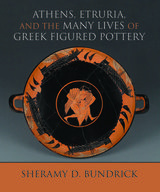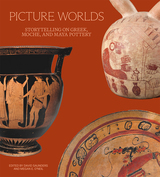
Thousands of Greek painted vases have emerged from excavations of tombs, sanctuaries, and settlements throughout Etruria, from southern coastal centers to northern communities in the Po Valley. Using documented archaeological assemblages, especially from tombs in southern Etruria, Bundrick challenges the widely held assumption that Etruscans were hellenized through Greek imports. She marshals evidence to show that Etruscan consumers purposefully selected figured pottery that harmonized with their own local needs and customs, so much so that the vases are better described as etruscanized. Athenian ceramic workers, she contends, learned from traders which shapes and imagery sold best to the Etruscans and employed a variety of strategies to maximize artistry, output, and profit.

Although the treasury of King Croesus held great quantities of gold and silver plate, the Lydians clearly loved fine ceramic wares imported from Greece. This preference was entirely appropriate for the capital of the expansive Lydian Kingdom, which occupied a pivotal position between the city states of the Greeks and the gigantic empire of the Persians. The importation of Greek pottery corresponds to the visits from poets, philosophers, and politicians mentioned by the historian Herodotus.
This collaborative work consists of three generously illustrated sections presenting the ceramic finds excavated at Sardis, but produced in the mainland Greek centers of Corinth, Athens, and Sparta. Judith Snyder Schaeffer analyzes the Corinthian imports, Nancy H. Ramage the Attic, and Crawford H. Greenewalt, Jr., the Lakonian. Their study of this material from the Harvard-Cornell excavations at Sardis offers new evidence of the taste for specific Greek wares and shapes in Anatolia before the time of Alexander the Great.


Satyrs and sphinxes, violent legumes, and a dancing maize deity figure in the stories painted on the pottery produced by the ancient Greek, Moche, and Maya cultures, respectively. Picture Worlds is the first book to examine the elaborately decorated terracotta vessels of these three distinct civilizations. Although the cultures were separated by space and time, they all employed pottery as a way to tell stories, explain the world, and illustrate core myths and beliefs. Each of these painted pots is a picture world. But why did these communities reach for pottery as a primary method of visual communication? How were the vessels produced and used? In this book, experts offer introductions to the civilizations, exploring these foundational questions and examining the painted imagery. Readers will be rewarded with a better understanding of each of these ancient societies, fascinating insights into their cultural commonalities and differences, and fresh perspectives on image making and storytelling, practices that remain vibrant to this day.
This volume is published to accompany an exhibition on view at the J. Paul Getty Museum at the Getty Villa from April 10 to July 29, 2024, and at the Michael C. Carlos Museum at Emory University from September 14 to December 15, 2024.
READERS
Browse our collection.
PUBLISHERS
See BiblioVault's publisher services.
STUDENT SERVICES
Files for college accessibility offices.
UChicago Accessibility Resources
home | accessibility | search | about | contact us
BiblioVault ® 2001 - 2024
The University of Chicago Press









